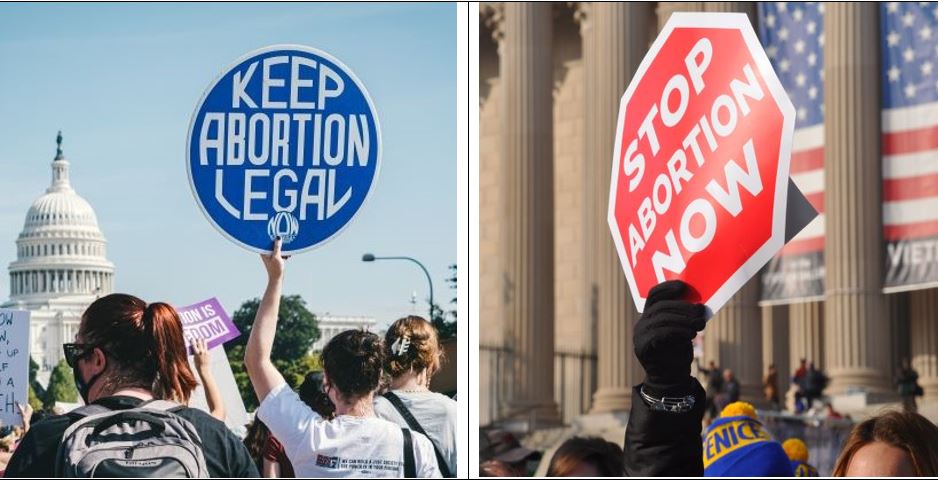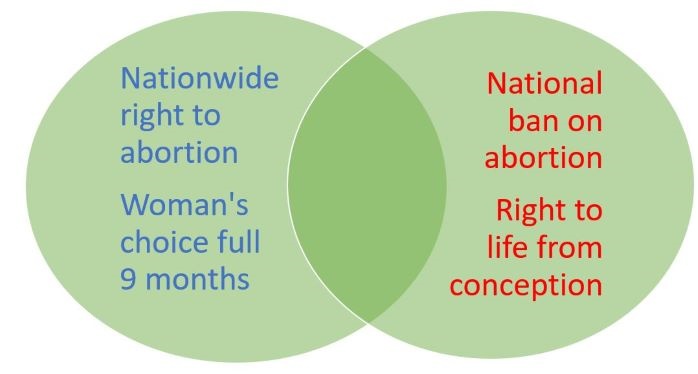
24 Jun Abortion: A Solution
The U.S. Supreme Court has issued its ruling, and today the judge-created national right to abortion throughout America is over. “Finally!” one group exclaims. “Now we can enact state laws to stop the murder of unborn babies everywhere!” “Horrific!” others yelp. “My body, my choice!”
In this divided situation—one that has persisted for five decades—each faction insists on its way completely, and candidates exploit the controversy to win elections. This tragedy will not end, and now the situation will get worse as the political fight expands to every state in the union. All future state legislative and governor races will focus on abortion, to the disregard of other issues.
Finding a Solution
So, “How do you solve problem like abortion?” The first step in solving any problem is to admit there is one. Regarding abortion, can we all at least agree that there is a dilemma, however you may define it? Please take a look at this diagram, which shows the contrasting positions:

This blogger, as a mediator and business litigator, has seen resolutions reached in some of the most entrenched business and legal conflicts imaginable. Based on this background, we believe that to solve any dispute, you must negotiate.
Please look again at the illustration above. This intentionally was designed as a Venn diagram, with a section in the middle where the two main ovals overlap.
To reveal this shared middle, one must first clear away some obstacles covering it—the unrealistic hopes of both sides that they can, in fact, obtain a complete victory. For one extreme, that would mean no abortions ever again. For the other, that would mean a woman’s unfettered right to abortion. Neither of those goals ever is going to be attained in the real world. Moreover, please realize that the vast majority of people in America do not want either one of those outcomes. Americans overwhelmingly support something in the middle.
The middle ground that most Americans want can be expressed in either of two ways:

A national law banning abortion could have exceptions for situations of rape, with all pregnant minors considered to have been statutorily raped, as this blog initially proposed in A Principled Federal Role in Abortion (July 23, 2021). When pregnancy resulted from rape, an abortion could be obtained in the first 20 weeks or some other agreed period. The life of the mother being at stake is a second exception.
Circumstances matter. The vast majority of Americans believe that abortion should be allowed, sometimes. Timing also matters. Most people believe the day after is different from the ninth month, and that, after some point in time, abortion should not be allowed.
To the most strident among you, we realize that moving toward the middle is not what you really want. A resolution by compromise, however, is better than the situation that has existed either under the now-reversed Roe v. Wade or the troubling future after the new Dobbs decision, as we wrote in If Roe v. Wade is Overturned (December 3, 2021). For the pro-life side, this blog’s proposed resolution would ensure that there are no late-term abortions in any state (except to save the woman’s life), no woman would be traveling from state-to-state looking for an abortion, and the lives of viable fetuses would be preserved. From the pro-choice perspective, all minors and others who have been raped could choose abortion, and the practice of unsafe, “back alley” abortions could be eliminated. A fear of perhaps half the states illegalizing abortion entirely would be alleviated.
Is not the certainty of such a compromise better than the downside of prolonging the fight for unconditional surrender? Beyond the impossibility of either faction winning that fight, the inconsistency between states and the rancor in every state will be worse than at present, while some raped women will be unable to find an abortion and some near-full-term pregnancies will end on a whim.
Americans Will Thank You
The Supreme Court majority is correct that democracy is better served if the nation’s most difficult problems are resolved by our elected representatives, rather than by judges using rules (i.e., the Constitution) that do not really address the problem, as is the case with abortion. If Congress can stand on common ground to pass a law that will cover all 50 states, that would be deeply appreciated.*
*Some astute readers may be wondering how reaching a political compromise is principled, as in our name, Principle Based Politics. This blog believes that resolving the problem of abortion as suggested here honors our principles of peace, law and justice, service, freedom, integrity, limited government, and protecting the vulnerable. Regarding the last listed principle, both the woman and the fetuses are vulnerable, and one or the other will be unprotected without a resolution, as we explained July 20, 2021, in Abortion: Weighing the Principles.
Compromise can happen if politicians will forgo their immediate electoral tactics and rationally explain to voters that such a compromise is (1) an improvement over the status quo, (2) better than the divisive and murky future, and (3) the best resolution that is feasible. Ideal is not an option. Remember, perfect is the enemy of good.
Written by Quentin R. Wittrock, founder of Principle Based Politics.
Look for his posts each week, as this blog will explore and promote the idea of principle in politics, both as to individual elected leaders and our federal government as an institution.


Eleanor Amundsdotter
Posted at 13:32h, 15 AugustWhen Roe v Wade was won, I was in college. Most of us cheered this decision because the back alley alternative was abhorrent. Then it started to become the ONLY solution to an unwanted pregnancy. The proponents focused solely on abortion, and left contraception and abstinence by the roadside.
And here we are today, fighting for extremes again. We must encourage Planned Parenthood to promote being inclusive of all matters bearing on women’s health as well as contraception, and contraception by both partners in lovemaking. The right to an abortion must be tied to the responsibility to avoid pregnancy in the first place. Why is this so hard?
That is principled based parenthood………………………….that is why they chose the name: Planned Parenthood.
It is time we chose that route.
Admin
Posted at 18:45h, 15 AugustThis is an excellent comment. Thank you much for your great, principled insights!